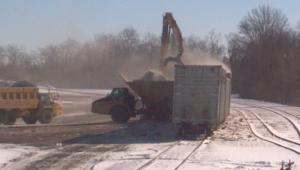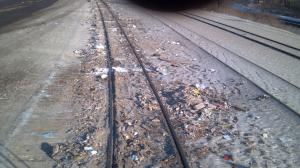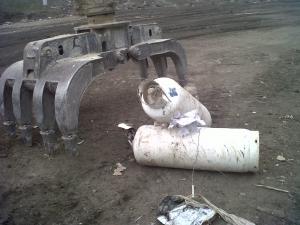Lordstown, Ohio Landfill Violates Water Pollution Limits by 1,500%

Waste unloading at the landfill occurs only 100 feet from a nearby stream. Contaminated water called "leachate" drains directly toward the stream. The landfill was cited for spilled waste in October 2021
Lordstown Landfill was previously cited for stormwater failures
In response, Lafarge submitted the required Non-Compliance Notification to the Ohio EPA which must specify the types and levels of contamination that were discharged. Total Suspended Solids (TSS), which can significantly impact water quality, was discharged from the landfill at a concentration of 641 mg/l on a permit limit of 45 mg/l. Copper, a metal contaminant also toxic to aquatic life, exceeded the permit limit by 25%. The landfill discharges into a tributary of Duck Creek which winds through the Village of Lordstown, Ohio. Fishing in Duck Creek further downstream of the landfill is common.
High TSS in stormwater or drinking water can have both environmental effects and effects on human health. According to StormwaterX, "Suspended solids reduce visibility and absorb light, which can increase stream temperatures and reduce photosynthesis. Impeding aquatic plant photosynthesis reduces the amount of food, habitat, and dissolved oxygen available for other species. Fine particles may also clog and abrade fish and insect gills and tissue and interfere with egg and larval development."
StormwaterX also states "Pollutants such as pesticides and PCBs adhere to the surfaces of TSS and can be transported into aquatic environments in this fashion. High TSS levels are often associated with higher levels of disease-causing microorganisms such as viruses, parasites, and some bacteria...". According to several sources, the contaminant copper damages the kidneys, nervous systems, and livers of most water creatures.
Based on a verified complaint against the Lordstown Landfill, the OhioEPA performed a thorough inter-divisional landfill inspection of the operation in September 2021. On October 5, 2021 the Ohio EPA issued three separate Notices of Violation and cited the Lordstown Landfill for 14 different environmental regulations. The violations included disposing of unacceptable waste, leaving spilled waste from the railcars lying on the ground which created contaminated water called "leachate", no dust control and improper landfill operations.
During the inspection the OhioEPA photographed waste in Lordstown's stormwater pond. The pond discharge point is only one hundred feet from the landfill's railcar waste unloading operation and contaminated solids drain directly to that pond.
The Lordstown Landfill disposes of approximately 5,000 railcars of demolition waste a year. The railed wastes originate in New York, New Jersey, Connecticut and Massachusetts. The landfill has disposed of more than 100,000 railcars of out-of-state waste since opening in 2004. The landfill also receives approximately 10,000 truckloads of waste a year.
Demolition waste often contains lead from soldered pipes, asbestos from floor tile and insulation, mercury from thermostats and fluorescent lighting, radioactive elements from pre-1968 radium watch-painting operations, mold spores on drywall, fiberglass from bathroom fixtures and pesticides and herbicides stored in old barns and outbuildings.
Demolition waste can also contain arsenic from wolmanized "green" patio lumber, PCBs from oil soaked wooden factory floors and contaminated paint as well as garage wastes such as oils, solvents, paints, gasoline tanks and asbestos from brakes.
Household hazardous wastes including bleaches, detergents, dyes, drain cleaners, polishes, insecticides, aerosol cans with chlorofluorocarbons, barbeque propane tanks, medical waste disposal containers and discarded drugs have been found in the landfill's waste.
Most of these pollutants can become TSS, or contaminate the discharged solids, and none of these hazardous substances are being monitored in the dust affecting landfill workers or the nearby neighbors.
The average building being demolished in the United States is 50 years older than the Environmental Protection Agency which was created by President Nixon in 1970. Therefore, none of the many federal and international product bans, such as for lead-based paint, arsenic, asbestos, hexavalent chromium, PCBs, DDT, PERC, chlorofluorocarbons, and mercury existed when millions of the aging homes, farms, factories and medical facilities were constructed and occupied.
The Ohio EPA has no regulation requiring homes to be cleaned out prior to demolition. However, asbestos or lead-based paint may require remediation if government financing is involved.
Demolition waste can also be pulverized and blended or "cocktailed" with hazardous wastes, medical wastes and sewage by unscrupulous out-of-state waste handlers. Waste handlers have a financial incentive to cocktail these wastes as they are many times more expensive to dispose of properly. The Ohio Legislature banned pulverized or “unidentifiable” wastes from demolition landfills in 2005.
Lafarge’s Lordstown Landfill has been cited for pulverized waste multiple times and again on October 5, 2021. An internal Lafarge report, since made public, outlines how sewage sludges from New York City were cocktailed into demolition waste and sent to Lordstown.
Mark Schmidt has over 35 years of experience in the waste industry and worked for both the Ohio EPA and Lafarge. He is both a certified geologist and a certified landfill manager. Mr. Schmidt is puzzled on how any company, particularly a global corporation, can be cited by the EPA for inadequate stormwater controls and then half a year later release significantly contaminated stormwater from the same spot.
Mr. Schmidt commented on Lafarge’s response in their Notice of Non-Compliance. Lafarge states the problem was caused by "Excessive rain during sampling event combined with snowmelt due to above freezing temperatures". According to Mr. Schmidt, "This is a poor excuse for Lordstown's excessive pollution. Stormwater structures are built to control runoff for all types of weather and storm events. Otherwise what good are stormwater controls? It is not supposed to be a wastewater pond."
Lafarge, the parent company of the Lordstown Landfill, is the world’s largest cement producer. Lafarge operates in more than 70 countries including Russia and China. News outlets have reported allegations Lafarge created environmental problems around the globe.
Lafarge has been indicted in France for crimes against humanity for cooperating with ISIS at their Syrian cement operation. CitizensAgainstLordstownLandfill.org also provides news links to other controversial Lafarge sites in New York, Paris, Ontario, Nova Scotia, the U.K., Nigeria, Zimbabwe, Syria and other locations.
Citizensagainstlordstownlandfill.org is an on-line clearinghouse for the hazards associated with working at or living near landfills.
Elijah Zander
citizensagainstlordstownlandfill.org
email us here
Legal Disclaimer:
EIN Presswire provides this news content "as is" without warranty of any kind. We do not accept any responsibility or liability for the accuracy, content, images, videos, licenses, completeness, legality, or reliability of the information contained in this article. If you have any complaints or copyright issues related to this article, kindly contact the author above.


